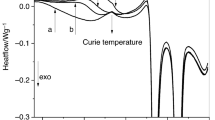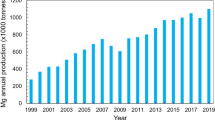Abstract
The glass transition phenomenon is guided by the swift cooling of a melt (glass-forming liquid). Consequently, the glass as a final product consists of a considerable number of micro-voids having the size of the order of atomic and/or molecular sizes. The model of free volume fluctuation helps in describing the diverse physico-chemical properties of amorphous materials (like glasses and polymers). This theory is based on the fraction of fluctuation free frozen at the glass transition temperature and it forms a basis for determination of various significant thermo-mechanical properties. In the present work, Vickers hardness test method is employed that provides useful information concerning the mechanical behavior of brittle solids. The present work emphasizes the results of micro-indentation measurements on recently synthesized novel Se78−x Te20Sn2Cd x glassy system. Basic thermo-mechanical parameters such as micro-hardness, volume (V h), formation energy (E h) of micro-voids in the glassy network and modulus of elasticity (E) have been determined and their variation with glass composition has been investigated.






Similar content being viewed by others
References
M. Popescu, Disordered chalcogenide optoelectronic materials: phenomena and applications. J. Optoelectron. Adv. Mater. 7, 2189–2210 (2005)
P. Lucas, M. Riley, C. Boussard, B. Bureau, Advances in chalcogenide fiber evanescent wave biochemical sensing. Anal. Bio. Chem. 351, 1–10 (2006)
P. Lucas, M.A. Solis, D. Le Coq, C. Juncker, M.R. Riley, J. Collier, D.E. Boesewetter, C. Boussard, B. Bureau, Spectroscopic properties of chalcogenide fibers for biosensor applications. Phys. Chem. Glasses 47, 88–91 (2006)
T. Ohta, Phase change optical memory promotes the DVD optical disc. J. Optoelectron. Adv. Mater. 3, 609–626 (2001)
A.M. Andriesh, M.S. Iovu, S.D. Shutov, Chalcogenide non-crystalline semiconductors in optoelectronics. J. Optoelectron. Adv. Mater. 4, 631–648 (2002)
N. Mehta, Application of chalcogenide glasses in electronics and optoelectronics: a review. J. Sci. Ind. Res. 65, 777–786 (2006)
W. Vogel, Chemistry of glass (The American Ceramic Society, Columbus, 1985)
V.F. Kokoring, Glasses For infrared optics (CRC Press, Boca Raton, 1996)
S.-W. Chen, M.-H. Lin, B.-R. Shie, J.-L. Wang, Infrared reactions in As-Se/Zn. J. Non-Cryst. Sol. 220, 243–248 (1997)
S.-D. Ho, Y.-M. Dai, S.-W. Chen, J.-L. Wang, Glass formation, density, microhardness and microstructure of the As-Se-Te chalcogenide alloys. J. Non-Cryst. Sol. 221, 290–296 (1997)
R.H. Hopkins, W.E. Kramer, G.B. Brandt, J.S. Schruben, R.A. Hoffman, K.B. Steinbruegge, T.L. Peterson, Fabrication and evaluation of erosion-resistant multispectral optical windows. J. Appl. Phys. 49, 3133–3139 (1978)
F. Sava, Structure and properties of chalcogenide glasses in the system (As2S3)1−x (Sb2S3) x . J. Optoelectron. Adv. Mater. 3, 425–432 (2001)
M.L. Trunov, Photo-induced plasticity in amorphous chalcogenides: an overview of mechanisms and applications. J. Optoelectron. Adv. Mater. 7, 2235–2246 (2005)
A.K. Varshneya, Daniel J. Mauro, Microhardness, indentation toughness, elasticity, plasticity and brittleness of Ge-Sb-Se chalcogenide glass. J. Non-Cryst. Sol. 353, 1291–1297 (2007)
V. Vassilev, M. Radonova, S. Boycheva, Glass formation the GeSe2-Sb2 Te3-CdSe system. J. Non-Cryst. Sol. 356, 2728–2733 (2010)
H. Kumar, A. Sharma, N. Mehta, Effect of Bi-incorporation on some thermo-mechanical properties of glassy Se78Te20Sn2 alloy. J. Optoelectron. Adv. Mater. 14, 899–904 (2012)
H. Kumar, A. Sharma, N. Mehta, Effect of lead incorporation on some thermo-mechanical properties of glassy Se78Te20Sn2 alloy. Mater. Foc. 2, 184–187 (2013)
A. Srivastava, N. Mehta, Investigation of some thermo-mechanical and dielectric properties in multi-component chalcogenide glasses of Se-Te-Sn-Ag quaternary system. J. Alloy. And Comp. 658, 533–542 (2016)
M.M. Smedskjaer, J.C. Mauro, Y. Yue, Prediction of glass hardness using temperature dependent constraint theory. Phy. Rev. Lett. 105, 115503 (2010)
L. Ainsworth, The diamond pyramid hardness of glass in relation to the strength and structure of glass. J. Soc. Glass Technol. 38, 479–547 (1954)
J.H. Westbrook, Hardness temperature characteristics of some simple glasses. Phys. Chem. Glasses 1, 32–36 (1960)
J.E. Neely, J.D. Mackenzie, Hardness and low temperature deformation of silica glass. J. Mater. Sci. 3, 603–609 (1968)
N.A. Ghoneim, H.A. Batal, Microhardness and softening point of some alumino-borate glasses as flow dependent properties. J. Non-cryst. Sol. 55, 343–351 (1983)
S.K. Arora, G.S. Trivikramaand, N.M. Batra, Vickers micromechanical indentation of BaMoO4 crystals. J. Mater. Sci. 19, 297–302 (1984)
S.V. Bovcheva, V.S. Vassilev, P. Petkov, New chalcogenide glasses in the GeSe2-As2Se3-CdTe system. J. Optoelectron. Adv. Mater. 3, 503–508 (2001)
L. Tichy, H. Ticha, Covalent bond approach to the glass-transition temperature of chalcogenide glasses. J. Non-Cryst. Sol. 189, 141–146 (1995)
M. Vlcek, M. Frumar, Model of photoinduced changes of optical properties in amorphous layers and glasses of Ge-Sb-S, Ge-S, As-S, and As-Se systems. J. Non-Cryst. Solids 97&98, 1223–1226 (1987)
E. Savova, E. Skordeva, E. Vateva, The topological phase transition in some Ge-Sb-S glasses and thin films. J. Phys. Chem. Sol. 55, 575–578 (1994)
E. Skordeva, D. Arsova, A topological phase transition in ternary chalcogenide films. J. Non-Cryst. Sol. 192&193, 665–668 (1995)
V. Vassilev, M. Radonova, S. Boycheva, Glass formation in the GeSe2-Sb2Te3-CdSe system. J. Non-cryst. Sol. 356, 2728–2733 (2010)
G. Saffarini, Compositional trends of the compactness in ternary chalcogenide glasses of the Ge-In-Se system. Phys. B 253, 52–55 (1998)
L. Aljihmani, K. Petkov, V. Vassilev, Glass forming region in GeSe2-GeTe-PbTe system and some physicochemical properties of glassy alloys. J. Non-cryst. Sol. 358, 364–367 (2012)
Acknowledgements
NM is thankful to his university for providing grant under the consumable head of DST-Purse program-(5050).
Author information
Authors and Affiliations
Corresponding author
Rights and permissions
About this article
Cite this article
Kumar, A., Mehta, N. Correlation between some thermo-mechanical and physico-chemical properties in multi-component glasses of Se-Te-Sn-Cd system. Appl. Phys. A 123, 410 (2017). https://doi.org/10.1007/s00339-017-1028-9
Received:
Accepted:
Published:
DOI: https://doi.org/10.1007/s00339-017-1028-9




